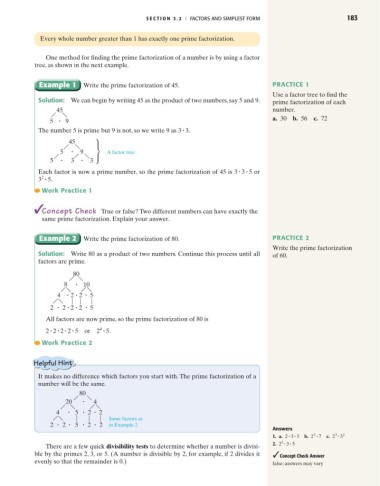Page 206 - Basic College Mathematics with Early Integers
P. 206
S E C T I O N 3.2 I FACTORS AND SIMPLEST FORM 183
Every whole number greater than 1 has exactly one prime factorization.
One method for finding the prime factorization of a number is by using a factor
tree, as shown in the next example.
Example 1 Write the prime factorization of 45. PRACTICE 1
Use a factor tree to find the
Solution: We can begin by writing 45 as the product of two numbers, say 5 and 9. prime factorization of each
45 number.
√ ≈ a. 30 b. 56 c. 72
5 # 9
#
The number 5 is prime but 9 is not, so we write 9 as 3 3.
45
√ ≈
5 # 9 s A factor tree
√ √ ≈
5 # 3 # 3
# #
Each factor is now a prime number, so the prime factorization of 45 is 3 3 5 or
3 2 # 5.
Work Practice 1
Concept Check True or false? Two different numbers can have exactly the
same prime factorization. Explain your answer.
Example 2 Write the prime factorization of 80. PRACTICE 2
Write the prime factorization
Solution: Write 80 as a product of two numbers. Continue this process until all of 60.
factors are prime.
80
√≈
8 # 10
√≈ √ ≈
# # #
4 2 2 5
√≈ ƒ ƒ ƒ
2 2 2
2 # # # # 5
All factors are now prime, so the prime factorization of 80 is
# # # #
2 2 2 2 5 or 2 4 # 5.
Work Practice 2
It makes no difference which factors you start with. The prime factorization of a
number will be the same.
80
20 √ # ≈ 4
√≈ √ ≈
4 # 5 # 2 # 2
√≈ ƒ ƒ ƒ Same factors as
2 # 2 # 5 # 2 # 2 in Example 2
Answers
# #
1. a. 2 3 5 b. 2 3 # 7 c. 2 3 # 3 2
3 5
2. 2 2 # #
There are a few quick divisibility tests to determine whether a number is divisi-
ble by the primes 2, 3, or 5. (A number is divisible by 2, for example, if 2 divides it Concept Check Answer
evenly so that the remainder is 0.) false; answers may vary

